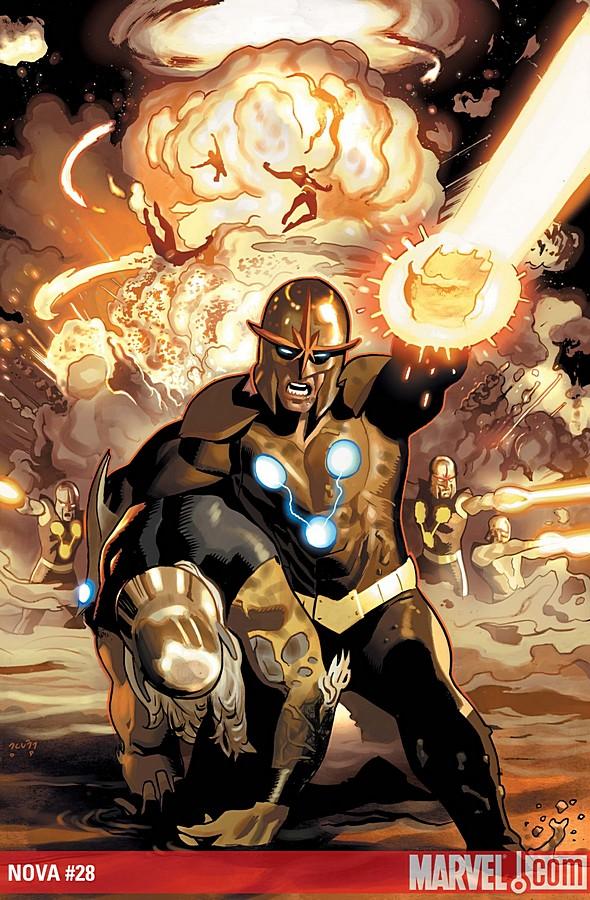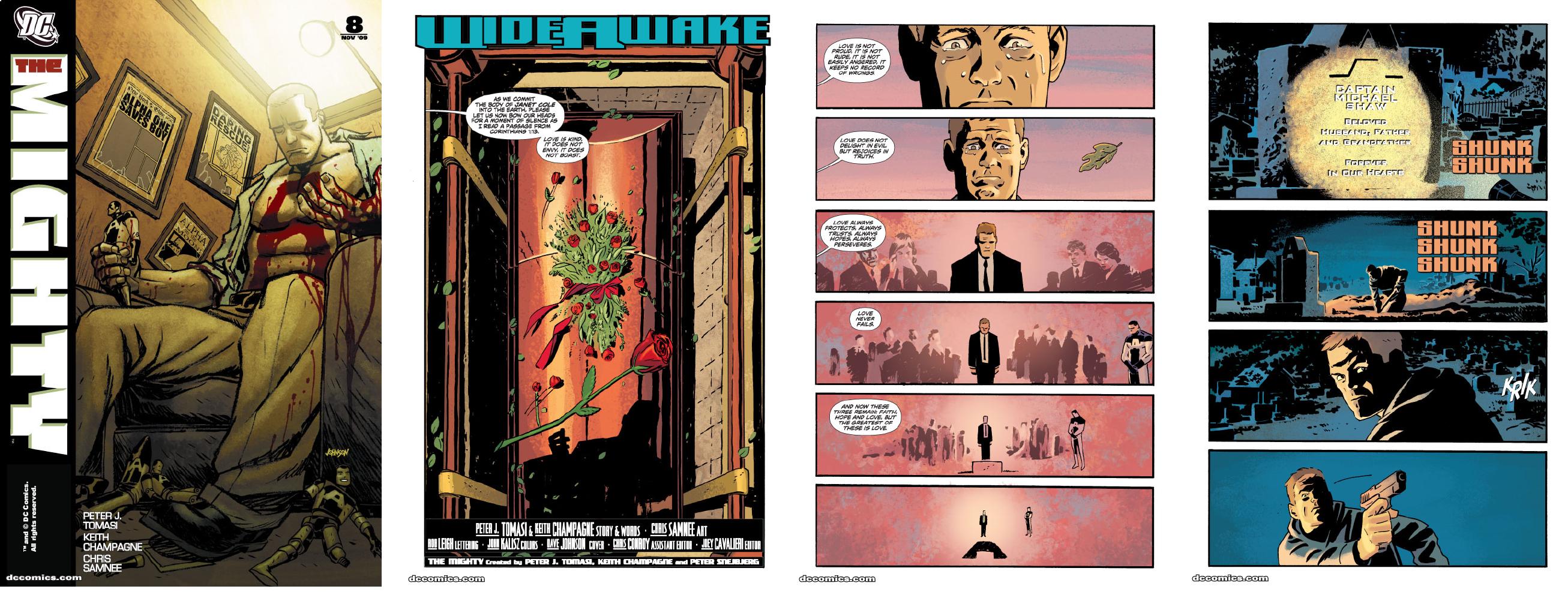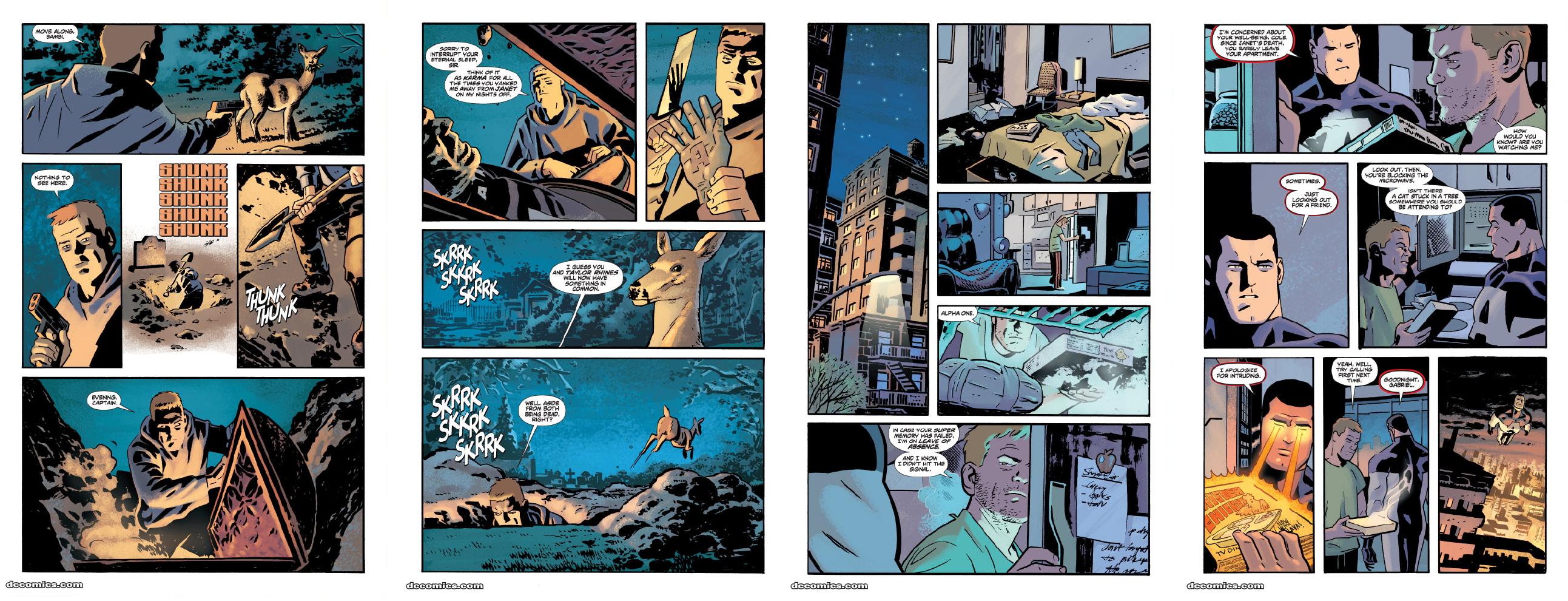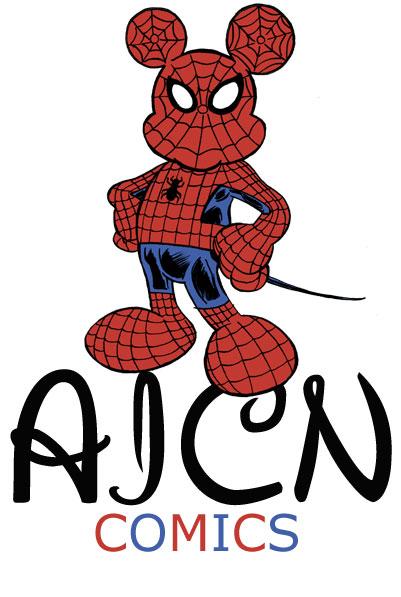
| #16 | 8/26/09 | #8 |
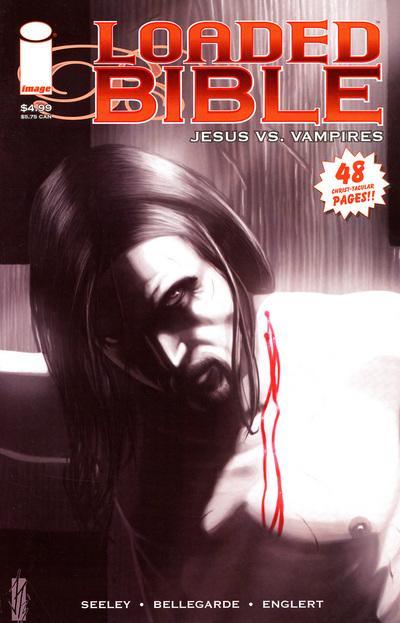
Hey folks, Ambush Bug here. If any of you noticed, this week we didn’t have a Shoot the Messenger column (hey, a couple people noticed), so I wanted to drop this tidbit of news for you before we dive into the reviews.
Turns out LOADED BIBLE, Tim (HACK/SLASH) Seeley’s awesome story about Jesus fighting vampires in the post-Apocalyptic future, is going to be made into an illustrated film a la Matt Pizzolo’s GODKILLER. Both Tim and Matt were part of my panel at the last San Diego Comic Con and I can tell you, both are as cool as they are talented. Can’t wait to see how this LOADED BIBLE news develops. Look for the whole story here.
Secondly, we have a preview of a book that comes out today from DC. THE MIGHTY has shaped up to be a helluva mystery AND a helluva good time. Check out this preview of the book.
THE MIGHTY #8
Writer: Peter J. Tomasi & Keth Champagne
Art: Chris Samnee
Publisher: DC Comics
Release Date: This Wednesday!
Oh yeah and there was some news about Marvel being bought by a mouse or something….
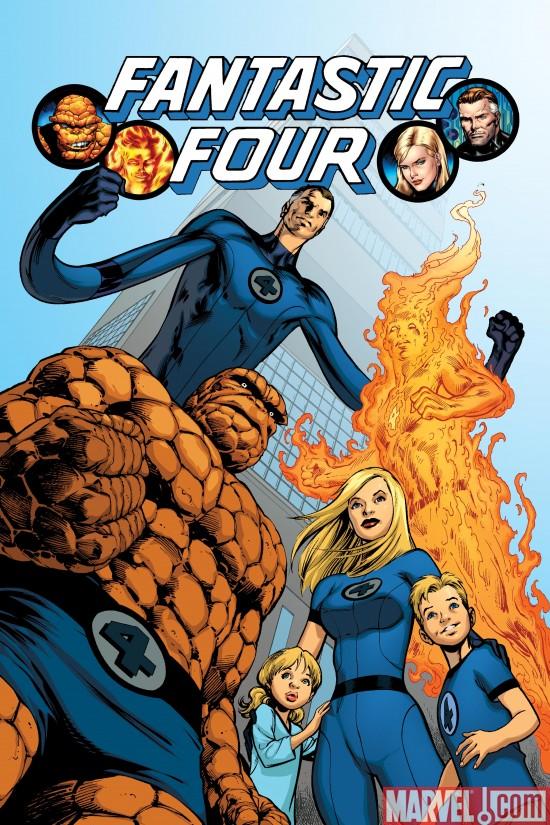
FANTASTIC FOUR #570
Writer: Jonathan Hickman Artist: Dale Eaglesham Publisher: Marvel Comics Reviewed by Humphrey Lee
Maybe I am just starting to become officially jaded about my comic books, but lately it seems like there have been less and less announcements out of the cons and newsfeeds about new books or new runs from the Big Two that have really got me excited in the past year or so. I'm not a complete cynic, calling doom and gloom on the industry or any of that jazz, I just happen to think that after starting off this decade/century with such a rush of fresh ideas and excitement in what has probably been the best stretch for comics well, ever, we're starting to see the industry wind down again. We still get a good flow of those announcements though, those ones you read in convention coverage that make you exclaim "Fuck yeah I'm buying that!" when you catch the creative team, premise, etc, and when this run on FANTASTIC FOUR by Hickman and Eaglesham was announced at NYCC earlier this year I definitely gave a little "fuck yeah" of my own at that piece of news. I even did a little fist pump. Yeah, I'll own up to that. And now the wait is over for what I honestly think has been the creative endeavor I've been looking forward to the most all summer (well, outside of STUMPTOWN coming in a couple months) and I'm so glad to say that this book is definitely the shining example of what we need to get out of whatever rut we find our beloved medium in.Given, we had a nice sampling of what to expect from Mr. Hickman at the helm with his DARK REIGN: FF mini just a bit ago, which was filled with all sorts of good, old-fashioned, high concept sci-fi (spelled with 'i's, like it should be) and some fun character moments. A great sign of what we have here in the debut issue, which has both those elements in spades, and works the "First Family" angle a good bit as well. Now, I will admit to a little bit of, I don't want to say skepticism at first, but it did take a solid half of the issue for me to start to get into what he was throwing at us. The opening two pages, a flashback into Reed's childhood that shows the building of his determined stature, are very grabbing indeed, but the next half dozen or so pages following it, a conflict involving the Wizard and his "sons" (accelerated clones of himself) felt a little... "disjointed" is what I would say. There was some cool fighting and whatnot, but it somewhat raced through the fight, to the revelation of the cloning, to Reed having a conversation with the Wizard himself about Godliness. Interesting stuff, but played out a little too quick for my tastes. But, as soon as the fisticuffs end the real good stuff begins... with a bedtime story.
The second half of this issue shows a lot of what I thought the DR mini was a little lacking in, and that's the family moments. Within a handful of pages, Hickman is able to establish a wonderful grasp on the heart of this book and what has made this title different from all the tights and tussle books as long as it has been around. And it also gives more weight behind Reed's motivation to revisit his "Bridge" invention from the DR mini, a device that gives him access to countless alternate realities, and that he theorizes will give him the necessary information from observing them to fix the problems he perceives as plaguing his own. A roomful of Reed Richards from multiple realities and the "Holy Shit!" moment of three of them carrying around their own Infinity Gauntlets later, and you have yourself a situation where I want the next issue pretty much now, another rarity I find myself experiencing these days.
And since I just spent three paragraphs more or less extolling the virtues of the brains of the operation, I'd feel remiss if I didn't do the same for the hands (and probably with an assist on the brains as well I'd imagine). I've been a fan since I first ran across his work on the last incarnation of DIAL H FOR HERO but it's an easy call that this is hands down the best I've ever since his work. The lines are so soft, and packed with so much expression and detail, it's actually astounding. And if there was ever any one flaw that I perceived of his work, it's that I always thought his figures were a bit bulky, even for the muscles and spandex type books, and that is completely reined in here. Yeah, Reed is just a smidge buffer than you'd think of him as, but oh well. For the sheer excellence that is the overall quality of his body of work, this is nothing but the nittiest of nitpicks. Honestly, this is probably my favorite art on a mainstream title just outside of what Quitely and JHW3 are doing on the Bat-books right now.
There's just something about an FF run that gets it, though, that really gets me excited, and it's obvious that Hickman gets this book. I love the interaction between the characters, I love the action, and I love the high sci-fi, and we get every one of these in spades. This title isn't one I buy all the time, it takes a special creative team that I think has the ability to take what makes it special and bring it out on the page to get me interested in it, and I have to say this is the most invested I've been in this book since the Waid/Ringo days, which I think is about as much praise as you can heap on a book. Obviously that's a big order to live up to, and we're just getting started here, but given what I've seen so far I have nothing but high hopes that we'll get something as special as that classic run.
Humphrey Lee has been an avid comic book reader going on fifteen years now and a contributor to Ain't It Cool comics for quite a few as well. In fact, reading comics is about all he does in his free time and where all the money from his day job wages goes to - funding his comic book habit so he can talk about them to you, our loyal readers (lucky you). He's a bit of a social networking whore, so you can find him all over the Interwebs on sites like Twitter, The MySpaces, Facebookand a Blogger Account where he also mostly talks about comics with his free time because he hasn't the slightest semblance of a life. Sad but true, and he gladly encourages you to add, read, and comment as you will.
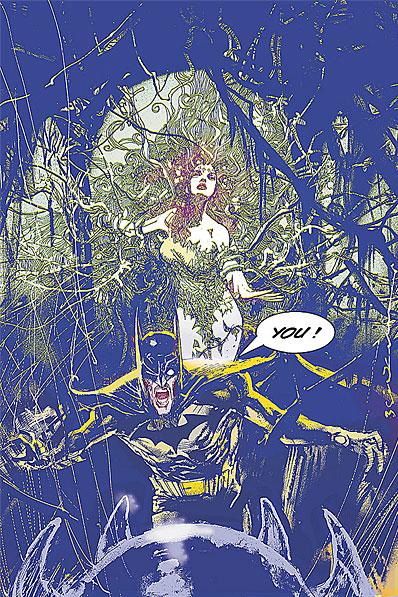
BATMAN: THE WIDENING GYRE #1
Writer: Kevin Smith Artist: Walt Flanagan Inker: Art Thibert Colorist: Art Lyon Publisher: DC Comics Reviewer: Matt Adler
Kevin Smith’s latest foray into the Bat-verse takes him into some familiar Batman territory, but also provides an exploration of some interesting themes, and a tone that is somewhat of a departure from the current Batman comics. Smith’s last Batman effort, BATMAN: CACOPHONY (also with longtime friend and artist Walt Flanagan) faced some criticism both for the writing and the art, as well as behind-the-scenes issues having to do with Smith’s late and incomplete works at Marvel, including SPIDER-MAN/BLACK CAT: THE EVIL MEN DO and DAREDEVIL: THE TARGET.There’s really not much Smith can do right now to quiet the complaints on the latter issue; Marvel is likely uninterested in completing a 6 issue miniseries of which only 1 issue came out 6 years ago (in addition, it seems there’s been a falling out between with Smith and Marvel, with Smith reportedly miffed at EiC Joe Quesada for not supporting him more publicly in response to fan criticism). And the only way the complaints about lateness will be quieted is if Smith establishes a better track record in the long run, something he has promised to do with this series, having built in a 6 month gap between the first and second halves of this 12 issue series.
As for the writing and art, both Smith and Flanagan have stepped up their game here. Smith is well-known for reading online critiques of his work (and sometimes taking them too much to heart), and he’s admitted to reading them while working on CACOPHONY. In a sign of growth and maturity as a creator, rather than getting angry about the criticism, he’s using it to improve, specifically citing his efforts to tone down some of the vulgarity, as well as overly-verbose dialogue. There’s still some PG-13 stuff here, particularly laying on Poison Ivy’s sexuality pretty thick, but still, the adjustments Smith has made are readily apparent.
With CACOPHONY, there were also criticisms that Flanagan’s art was too cartoony, but Flanagan too has grown as an artist. Smith has said they are trying to evoke the classic Steve Englehart/Marshall Rogers run on Batman, and that influence is very apparent in Flanagan’s art. Like Rogers, Flanagan manages to portray Batman as a human being, with all the range of emotion that implies. There are also several standout panels that are just really fun to look at, including a flashback scene of a young Robin (Dick Grayson) wearing a yarmulke and holding a torah scroll, and a grisly scene of one of Poison Ivy’s victims. And hey, if you’re going to do T&A, you might as well do it right; Flanagan’s Ivy is very sexy, along with amusingly placed foliage to cover up the naughty bits. To be honest, Flanagan’s art is so nice here, that I’d rather he did the covers than Bill Sienkiewicz.
As for the story, there’s a bit of a “greatest hits” feel to it, with most of the major Bat villains making at least a cameo as part of a tour through Arkham Asylum, including The Joker, The Riddler, Two-Face, Killer Croc, and the Mad Hatter. But this is to be expected anytime a major writer comes on for a stint; they want to play with the big guns. The Demon also makes an appearance, apparently because Flanagan wanted to draw him, and Smith does a much more clever and creative job with his rhymes than most writers.
This story takes place well before FINAL CRISIS, so Batman is still Bruce Wayne, although there are a number of moments in the issue that seem to foreshadow Bruce’s fate, including a scene where he muses on the ways he expects to die in the line of duty, and who would take over for him. Also seemingly tying in with the fallout from BATTLE FOR THE COWL is the major theme that permeates the issue, with Batman reflecting on the various Robins moving on to new identities, and having second thoughts about having kids as partners (given that Smith wrote the first six scripts before this issue came out, it’s possible that it’s just happy coincidence, but if not, DC and Smith should be commended on their coordination).
This is not a new issue for Batman (or for Captain America, for that matter), but what’s different here is that Batman concludes that his next partner should be an adult, already trained. This really just raises more questions; it’s been retroactively justified that Batman has had Robin as a partner as a way of connecting with his own lost childhood, but if we remove that aspect, why would the notoriously independent Batman even want a partner? That question isn’t really addressed, but in accordance with this line of thought, and as promised in interviews, Smith introduces a mysterious new vigilante who assists Batman at the end of the issue. He is not named yet, but going by the look of his mask, I’m going to say “The Gazelle” or “The Aardvark.” Smith has also said that this character will be spun off into his own solo series after THE WIDENING GYRE concludes, which seems like a tall order; there will have to be a lot of work done to make the character compelling enough to support his own series, after being featured in just one limited series. But hey, he’s got 11 more issues; let’s see what happens.
In most places, Matt Adler goes by the name his mother gave him, but occasionally uses the handle "CylverSaber", based on a character he created for the old DARK FORCES II: JEDI KNIGHT game (one hint of his overweening nerddom). He currently does IT and networking support for the government of Nassau County, NY, but his dream is to write for a living, and is in the process of figuring out how to get publishers to give his stuff a look. In the meantime, he passes the time by writing for AICN, CBR, and a few other places. He has also written for MARVEL SPOTLIGHT magazine.
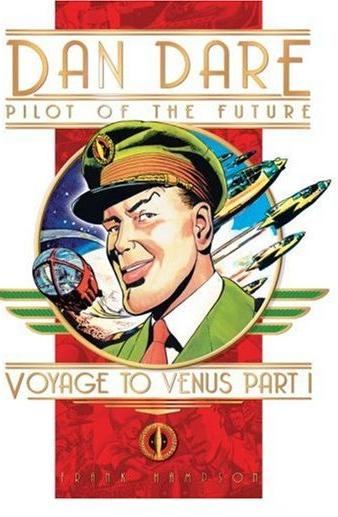
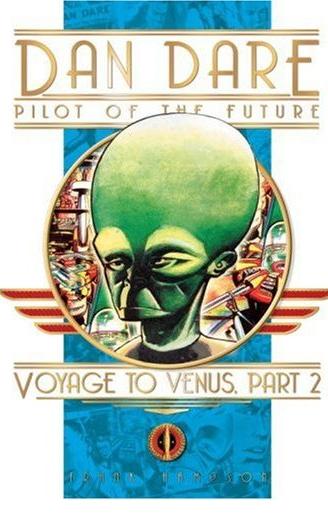
DAN DARE: THE VOYAGE TO VENUS I & II
Created by: Frank Hampson Published by: Titan Books Reviewed by: Baytor
Not terribly long ago, I got a mild rebuke in the Talk Back for saying I wasn’t a terribly big fan of the Golden Age (which was considered a bit strange for a comic reviewer to say). I’m actually a big fan of certain Golden Age books, but we comic fans know what we like and we tend to stick to it, and I’m as guilty of it as anyone else. Even when I got into British comics a few years back, it was because those 2000AD collections featured stories written by some of my favorite creators, and I made little effort to move past their stable of characters. So the notion that I “got into British comics” is a misnomer, as I only got into 2000AD. So in an effort to break out of my provincial tastes, I’ve embarked on a scheme to try out some of the better respected work of the Golden and Silver Age, and one of my first stops is DAN DARE, PILOT OF THE FUTURE.Some stuff ages really well, other stuff not so much. Dan Dare’s debut adventure falls into the latter category and the modern reader will have to take into account the time & place it was written. This is very much the product of post-War Britain, before the grim reality ground the English Dream of continuing their Empire under its heel; and while attitudes toward women and other cultures are improving, they still cling to a somewhat condescending, patriarchal attitude. To its advantage, the strip gleefully embraces the clichés of the day with a certain humorous flair that never seems self-conscious. This was, after all, a time when a rotund character (whose hobbies includes “sleeping”) will find himself inexplicably in his boxer shorts for obvious comic relief without the belief that this detracted from the drama of the main plot.
This is actually the second time I’ve experienced this story, having listened to a fairly dull, edited radio play of it. In a nutshell, Earth is rapidly approaching the end of its viability thanks to a growing food shortage and has hung its hopes on cultivating food on what they believe is an uninhabited Venus. But ship after ship blows up in the final stages of their voyage and Dan Dare & his trusty crew brave the risks, do the impossible, land on Venus, and find themselves at the start of the first interplanetary war thanks to the evil Mekon, Dan’s arch-enemy. Thankfully, it plays out much better in its original form, especially with the heaping doses of comedy doled out by Spaceman Digby and his boxer shorts. The various artists (all working to a similar style) often add a whimsical element to the art, such as the body language of Dare & Digby when they steal uniforms from a Venusian museum.
The story is told in a series of two-page strips, which often makes for a wonky dramatic structure as each installment needs to quickly reach a dramatic or comedic moment; so it’s not unusual for some bit of drama to be conveniently forgotten later on, such as a wig that Dan Dare uses to communicate with some savage blue-skinned Venusians, which he loses as an inconvenient time to set up a cliff-hanger…but which is totally forgotten several installments later when other Earthlings are freely communicating with the same people with no explanation. The same also occurs with the Venusian atmosphere, which is at first deadly to humans (except inside where it’s adjusted for their biology), but is forgotten the moment its necessary for the plot to have humans walking around without masks in the story’s finale.
Some of this might be due to the influence of Arthur C. Clarke, the noted science fiction author, who acted as a consultant for this tale. So perhaps it was Clarke who pointed out that the atmosphere on Venus wouldn’t be breathable by humans and that a savage people on Venus wouldn’t speak any known Earth language…only to have Frank Hampson cheerfully toss this out the moment it became inconvenient. In any event, fidelity to what has been established is not a major concern, which I find adds to the charm of the book.
Ultimately, the Classic DAN DARE strips get a qualified endorsement from me. There’s lots of fun to be had if you enjoy old-fashioned science fiction, with lots of humor and action, but not much in the way of realism. Well, at least not how we would define it today, but like a lot of science fiction of its era, it loves showing little diagrams that show how the various bits of tech work, such as the revolving floors that shift position depending on whether it’s Earth gravity or artificial gravity being used. It’s also one of the best looking books of its era. But be forewarned that you have to adjust your sensibilities to that of the 1950s and not judge it by modern standards.
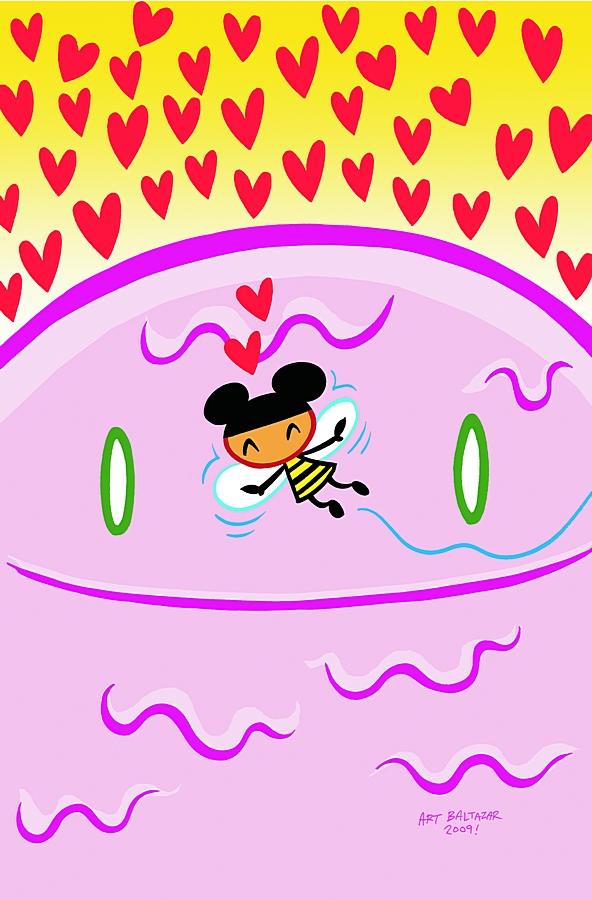
TINY TITANS #19
By Art Baltazar & Franco Publisher: DC Comics Reviewer: Ambush Bug
If you don't like TINY TITANS then your heart is cold and dead and probably smells and likely has a few cat-hairs stuck to it and I don't like you.What's not to like about this book?
It functions in its own continuity, but pays close attention as to what's going on in DC proper.
All of the adult super-heroes are depicted in true Charlie Brown-manner (you only see them from the waist down).
The art is cute and appealing and I always marvel at the way Art makes even the most lame looking Titan character cool looking with their distinctive style.
The book offers new and fresh takes on characters that I could give two shits about in DC proper (Bumblebee is the shit in this book, in the regular DCU, who gives a frag?).
The latter portion of the book is filled with activities such as word finds, puzzles, mazes, and games.
The book acknowledges every member of the Teen Titans past, present, and future, so if you're bored with one character, all you have to do is turn the page and WHA-BLAMM! New character!
And finally, and most importantly, it remembers a time when funny books were just that and it brings the funny in every page.
Sure occasionally a joke or two ranks high on the corny meter, but I have nothing but love to give this book.
Issue #19 is one of my favorites since this book began. Art & Franco talked about this issue at WizardWorld Chicago this year, touting this issue as the most girly issue of TINY TITANS ever. It's all about love, this one is. The first tale is a silent rainy day date between two unlikely characters; Bumblebee and Plasmus. Seeing them ride a bicycle built for two, enjoy ice cream, and bound around in a room full of super balls is enough to make even the coldest heart melt.
Story two shows Robin's women woes as he tries to get a report on flowers finished, but keeps on being interrupted by all of the hotties of the Teen Titans thinking that the flower Robin keeps drawing is for them.
Bumblebee and Plasmus are back for a second date to the movies in the third story, best part of that one being the visit to the concession stand.
Finally, the monkeys of the TINY TITANS universe chat about recruiting new members to their Titans Apes Club. It's got monkeys. Nuff blah blah-ed.
The rest of the book is filled with one-page stories like the two Wonder Girls getting their golden lassos tangled and a few Titans showing the reader how to properly eat a lollipop. Last week, someone commented in the talkbacks that reviewing comics for kids is pointless here at AICN Comics. Damn, that just made me sad. I hope I never, ever think that way. Reading comics like TINY TITANS appeals to that inner child in me that can't help but laugh when Croc gets a lollipop stuck to his face or stifle an "aww" when Bumblebee and Plasmus share a jellybean. I can enjoy heady Vertigo style comics like FABLES and SANDMAN. I can dig on mighty super-powered melees like WAR OF KINGS and BLACKEST NIGHT. But I never want to be so jaded that I can't remember to have fun while reading comics. TINY TITANS is good comics, boiling down the essence of what makes these characters appealing with simple art and stories that seem to ooze from that part of you that should never grow up. Art Baltazar and Franco have that in spades and thankfully are secure enough to express it in this amazing comic. Enjoy your THE BOYS or WALKING DEAD or whatever uber-violent/ultra-sophisticated comic du jour, but also remind yourself that it's also ok to like a book geared towards kids. Having won the Eisner this year, I hope this book will gain more readers and be around for a long, long time because for an industry that grew up from appealing to kids, we sure have steered a long way from that. TINY TITANS is that beacon of light there to steer anyone who lost that inner child who used to read comics on their belly in the family room back to that simpler, more fun time.
Ambush Bug is Mark L. Miller, reviewer and co-editor of AICN Comics for over eight years. Check out his short comic book fiction from Cream City Comics’ MUSCLES & FIGHTS VOL.3 and MUSCLES & FRIGHTS VOL.1 on his ComicSpace page. Bug was interviewed here and here at Cream City Comics. Look for more comics from Bug in 2009 from Bluewater Comics, including the sequel to THE TINGLER for their VINCENT PRICE PRESENTS ongoing series in stores September 2009 and VINCENT PRICE PRESENTS WITCHFINDER GENERAL and ROGER CORMAN PRESENTS DEATHSPORT to be released in late 2009/early 2010.

WEST COAST BLUES OGN
Writer: Jean-Patrick Manchette Art: Jacques Tardi Publisher: Fantagraphics Books Reviewer: Mr. Pasty
Reading WEST COAST BLUES is a good way to find out what would have happened to Willy Loman had his evil side emerged – kind of like “Superman III” when the Man of Steel got a taste of synthetic kryptonite. George Gerfaut is a salesman by trade, but spends his nights driving around Paris hopped up on bourbon and barbiturates and looking for trouble. He finds it in some unusual places, but then again this is an unusual book, like one of those movies where everyone talks cool and leads a life ten times more interesting than yours.One of the things that struck me right off the bat was how jarring the artwork was. The Pasty Peeps already know I loathe black and white comics, but the Gods have reached down and sharpened Tardi’s pencil, elevating a visceral literary style into a complex art form. Scenery is everything here. The characters resemble a cross between GASOLINE ALLEY and NANCY (post-1994) but their simplicity draws out the dynamic scenery and near-brilliant use of shading. As your typical phobic hetero, I could probably do without all the gratuitous dick-shots, but I understand they have a place in this story. Besides, there is no way I’m complimenting a cartoon cock just in case I ever decide to run for public office.
So Gerfaut finds himself in a bunch of self-induced predicaments. Watching him try to not just survive, but to also figure out a way to reverse the many precarious situations that befall him, is half the fun. The narrative comes full circle but is written without form. Like Gerfaut’s life, it often drifts from one mood to the next and never finds itself boxed in by its own limitations. Of course every whimsical scenario is relentless is its preposterousness, but again, the characters exist unlike the usual posturing heroes that populate some mainstream books. Not only do they behave as if there is no reader, they behave like there is no world except for what’s currently in front of them. Gerfaut is nearly killed by thugs at the beach. After he fights them off and returns to his family – a mere 30 feet away – he goes about his business like it never happened. I, on the other hand, spent the next three pages waiting for the other shoe to drop. Suspense, surprise, payoff – its all here – and realized by characters I was made to care about. Simply put, WEST COAST BLUES delivers.
Final word: If you read WEST COAST BLUES one time, you’ll enjoy it. If you read it twice, you’ll understand it. Three times and you’ll experience it. If the weekly rack is getting stale, part with some green and check this one out. You won’t soon forget it.
Web heads who can’t get enough of Mr. Pasty’s word vomit are encouraged to watch him operate as Nostradumbass over at here. MMAmania.com. Love, hate and Mafia Wars requests should be directed here.

GUARDIANS OF THE GALAXY #17
Writers: Dan Abnett and Andy Lanning Penciler: Brad Walker Published by: Disney… oops, I mean Marvel Reviewed by: BottleImp
Maybe it’s just that I’m getting old and cranky, but I remember the comics I read as a kid were a lot better than most of the crap being published today. Now I’ll freely admit that there’s a heavy layer of nostalgia obscuring the finer details of those long-ago purchases from the spinner rack, and I’m sure that the reality of the stories and artwork that I loved twenty years ago couldn’t possibly measure up to the illusion of perfection stored away in my imperfect memory. Nevertheless, there is one aspect of these older comics that does not pale upon re-reading: the sense of adventure.I blame Moore, Miller, Gaiman, and all those other breakout creators of the 1980s. They were so passionate about expanding the horizons of comic books beyond the four-color kiddie adventure, so determined to legitimize the medium as literature rather than trash, so desperate to proclaim, “Comics aren’t just for kids!”…and they succeeded. But at what cost? The intellectualism and mature subject matter has devolved into the turgid and the pretentious. Hell, even in the realm of superhero fantasy, the once polarizing and innovative “deconstruction” of those spandex gods has been utilized so often, it’s become the status quo. Comic books are now all-grown up—but in growing up, they’ve lost that childlike sense of wonder and excitement (which is probably why I never see anyone under the age of twenty-five in the local comic shops). The joy of escapist fantasy has been extinguished.
Well, not totally.
Like a beacon in the darkness, Marvel’s “cosmic” titles helmed by Abnett and Lanning are bringing that almost forgotten sense of FUN back to the comic page. And this month’s GUARDIANS OF THE GALAXY is no exception. Let’s see: great mix of characters? Check—alongside such archetypes as the sorcerer and the military man we have a talking tree, a talking raccoon AND a telepathic Russian dog (though not all in this issue, sadly). Danger and thrills on an epic scale? Check—a fissure in space that not only threatens to destroy the fabric of space/time, but also brings giant spaceship-ravaging tentacles. Humor to provide a little levity to the situation? Check—did I mention that GOTG features both a talking raccoon and a talking tree? And when Groot the talking tree teams up with the Inhumans’ Maximus the Mad, it’s a recipe for hi-larity! I smell a sitcom here…
Seriously, though, Abnett and Lanning have proven again that they know adventure. Just as NOVA channels that sense of wonder you once got from reading SPIDER-MAN, GOTG evokes that classic Marvel tradition of the Band of Misfits (either X-Men or Avengers—take your pick) who still manage to succeed despite their obviously flawed group dynamic.
And speaking of the classics, the end of this issue will be a real treat for all of you out there who are old enough to remember the cosmic stuff that Jim Starlin was doing for Marvel back in the late ‘70s and early ‘80s. Brad Walker renders a chilling cliffhanger that has me hanging on the edge of my seat—next month can’t come soon enough. Remember that feeling from when you were a kid? No? Then you’d better put down whatever dreary, pretentious crap you’ve been reading and check out some of the best stuff to grace whatever passes for the spinner rack these days.
When released from his Bottle, the Imp takes the form of Stephen Andrade, an artist/illustrator/pirate monkey painter from the Northeast. You can see some of his artwork athere. He’s given up comics more times than he can remember. But every time he thinks he's out, they pull him back in.
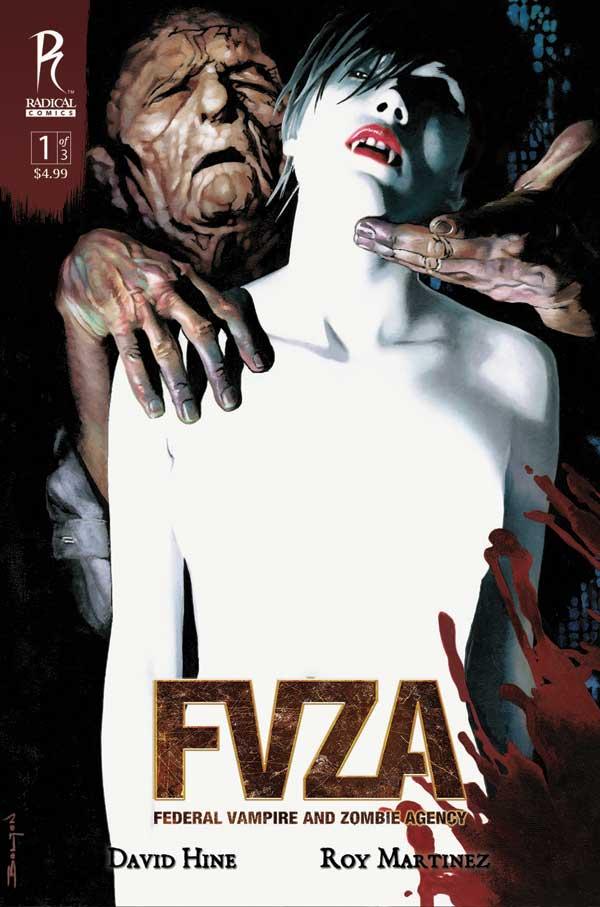
FVZA #1
Writer: David Hine Artist: Roy Allan Martinez Painters: Kinsun Loh & Jerry Choo Publisher: Radical Comics Reviewer: Matt Adler
This may be the first comic to be based on a website. I don’t mean based on a webcomic; FVZA.org is a site that purports to tell the “real” history of the world, as it has been overtaken by people infected with vampire and zombie viruses. It treats the subject completely seriously, and advises visitors on how to deal with the threat. Radical and writer David Hine have drawn upon the history created by the website’s author, Richard Dargan, to tell a story set in the present day as the world faces the resurgence of zombies and vampires.The artwork, by Roy Allan Martinez (SON OF M) is very much in line with Radical’s usual fare; this means, on the one hand that it is beautifully painted and ultra-realistic, coming across as movie stills (not unintentionally). On the other hand, this approach tends to homogenize the artist, removing a lot of the stylistic quirks we’ve seen in Martinez’s other work that made it interesting.
The central characters in this story are Dr. Hugh Pecos and his two grandchildren, now adults, whom he has raised since their parents were apparently killed by vampires. Pecos is the world’s foremost authority on the undead, and has dedicated his life to stamping them out. He’s been mostly successful till now, but is convinced that the undead are about to make their return, and has trained his grandkids in the martial arts in order to fight the threat he foresees. Pecos is very much an obsessive, coming across as a mix of Van Helsing and Captain Ahab. He’s so focused on the threat that he mostly ignores the feelings of the children he’s raising in favor of making sure they’re prepared.
Now grown, the two kids have developed very differently. Landra, the granddaughter, has embraced her grandfather’s cause and is very much the ass-kicker. Her brother Vidal is far more reluctant and skeptical, and has a strained relationship with their grandfather. Hine develops these characterizations very well, making the dynamic between Pecos and his grandchildren seem authentic. Although we don’t have vampires and zombies to deal with, most of us have encountered someone who is so focused on their work that they neglect their personal relationships, and Hine manages to portray that accurately in Pecos.
Another task Hine is faced with is weaving vampire and zombie history into real life events, since that is a central element of what the website does. For the most part it’s done very well and entertainingly, with sequences set in the Old West, for example. But one scene, which had victims of a Nazi concentration camp infected with the zombie virus, I was not entirely comfortable with. I understand that due to the nature of this project, there isn’t much choice but to address an important historical event such as the Holocaust in these terms, but I’m just not comfortable seeing a real life historical tragedy mixed with fantasy like that.
The zombies here are pretty standard; mostly mindless, shambling corpses, though we’re told they have some awareness of their condition, which increases their torment. The vampires retain their full intelligence, and some have banded together in a secret cabal to preserve their species under threat of extermination by humans. There are other, more ambitious vampires, who have greater goals than mere survival, and are willing to use the zombies (and the virus that creates them) for their own ends. These two factions of vampires come into conflict, but caught in the middle are two newly-turned vamps who have not yet fully lost their humanity, and are scared shitless about what they’ve fallen into. These characters are important, because they provide the point of view for the reader being introduced to this world for the first time.
This is only a 3 issue miniseries, but the set-up here is pretty compelling, and I could easily see this warranting an ongoing, or at least a series of miniseries. Hine’s crafted an engaging tale, and while I do wish Radical would allow for more variation in their art styles, Martinez tells the story effectively. A promising start.

BATMAN & ROBIN #3
Writer: Grant Morrison Artist: Frank Quitely Publisher: DC Comics Reviewer: Optimous Douche
Here Pyggy, Pyggy…Optimous wants to give your gloriously psychotic ass a big hug. For anyone that chooses to ignore the best comic on the spinner racks, my opening summons is offering some much deserved love to one of the most interesting Batman foils in recent memory. Morrison has crafted Pyg to be so fucking insane, it makes the Joker look a caricature of craziness, a mere circus clown by comparison.One of the overarching current “bat-complaints” (in quotes because it is insipid, stupid and overly fan-boyish) is that Dick Grayson is not Batman. For the first three pages of this issue, I could swear my left hand to God that Bruce Wayne had stopped fucking monkeys in the Paleolithic era, or whatever the hell he was supposed to be doing at the end of FINAL CRISIS, slipped back into the cowl and told Dick to go back and bang some alien broads in Titans Tower. Yes folks, Dick Grayson has finally manned up as he tears through the streets of Gotham on the Bat-cycle dragging alongside him one of Pyg’s foot soldiers. Once he has Pyg’s location the real fun starts. Fear not though, true believers, Dick does throw in some of his traditional trademark funny once the danger subsides.
Since the title is BATMAN & ROBIN, let’s not forget about Dick’s pint sized albatross with attitude. Let’s be honest, up until this point Damian has merely been the embodiment of douchiness wrapped in red and green. Morrison must have known that fan sympathy was waning by presenting this kid as “all attitude, all the time,” because for the first time the attitude is presented at the right time and place as he tries to escape from Pyg and balanced with some moments of genuine surprise and dare I say love after Dick rescues him.
Pyg ultimately gets his just desserts, but not until after his psychosis shines off the page. I’ll be the first to admit that Morrison loses me from a comprehension standpoint when he allows his characters to spout off in tangential tirades about fetish bologna and the waxing and waning of the moons of albacore, but like I said earlier, if the character is crazy to begin with, spouting crazy talk only seems natural. Also, when the crazy is balanced with Quitely masterfully rendering a knife dancing ballet set to “sexy, hot, disco” the moment transcends to delightful lunacy. I know the moment called for some authentic disco, but for some reason my internal soundtrack kept playing the modern disco styling of Scissor Sister’s “I Don’t Feel Like Dancing.” Once Pyg is done tormenting a captive Damian, the little lad uses his assassin upbringing to do some serious damage.
Batman uses his sleuthing to find out that Pyg is trying to infect Gotham with a virus that makes people addicted to other drugs, and also unveils that Pyg is far from the mastermind of this whole operation as exhibited by the “reveal” on the last page of…SPOILER…The Red Hood. Again though, while a good mystery, it’s the unique beats and moments of this book that left me absolutely enthralled.
It will be very interesting to see where issue 4 of this series is going to land. With Quitely taking a hiatus I have grave concerns. New artist Phillip Tan is accomplished, but as we have learned with much of Morrison’s work it takes a unique individual to convey his special brand of crazy. Will Tan be able to pictorially convey madness for the masses? I guess we’ll find out next month.
When Optimous Douche isn’t reading comics and misspelling the names of 80’s icons, he “transforms” into a corporate communications guru. "What if the whole world had superpowers? Find out in the pages of Optimous’ original book AVERAGE JOE. Read the first full issue on Optimous’ New Blog and see original sketches by fellow @$$hole Bottleimp. If you are a publisher or can help these guys get AVERAGE JOE up, up, and on the shelves in any way, drop Optimous a line."
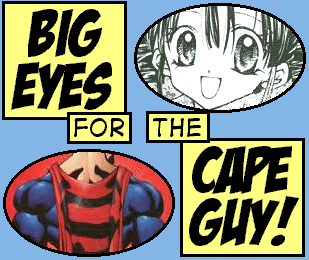
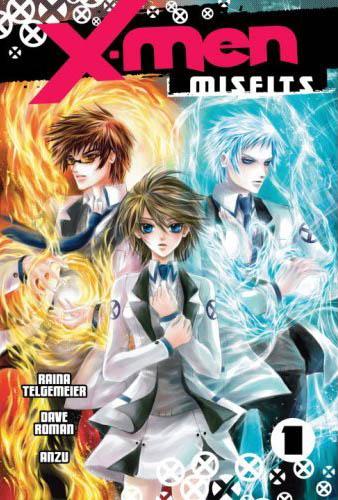
X-MEN: MISFITS V1
Story by Raina Telgemeier and Dave Roman Art by Anzu Released by Del Ray Reviewer: Scott Green
X-MEN: MISFITS is the second collaboration between Del Rey and Marvel to recast the mutant super heroes using manga genre tropes: Wolverine as a wild young outcast in the NARUTO tradition, Kitty Pryde as a schoolgirl surrounded by handsome, interested boys, along the lines of OURAN HIGH SCHOOL HOST CLUB. While some manga can transcend the boundaries of their intended demographics, both of the Del Rey/Marvel manga projects have been works for specific audiences. While capable of appealing to their target reader profiles, they have lacked the hook to convince someone disinterested in premise.My impression of the first, WOLVERINE: PRODIGAL SON, was that it was best suited to an audience who knew of the X-Men from the movies or cartoon, and knew of shonen manga from bits of its anime adaptations. Read too much WOLVERINE and the parent X-MEN comics or read too much manga, and paging through PRODIGAL SON would be apt to become an exercise in comparing the work to the traditions that inspired it.
Capturing the spirit of popular shoujo (intended for young to teenage girls) manga without blindly aping the model, and leveraging that aesthetic to produce memorable reinterpretations of X-Men's distinctive personalities, MISFITS does not require that caveat. Characters and themes remain recognizable, and as such, MISFITS is not an exercise of scrubbing away everything but the brand. However, its reimagining of the population and mechanics of an X-MEN story are sufficiently distinct from the aims of a super-hero story that MISFITS doesn't lend itself to be measured too stringently against the original comic. At the same time, it evokes the feel of Japanese shoujo manga capably enough that readers of the genre will not have cause to reject it.
The flaw in this grafting of shoujo and X-MEN is that it aims to accomplish too much in too little space. Written for a graphic novel rather than a weekly anthology like most manga or a monthly issue like most super-hero comics, character introductions and plot developments are densely packed into 160 pages. Bouncing from one significant moment to the next, there's little space to stop and appreciate the characters or their situation. The potential humor and chemistry of the situations don't have enough time to fully develop, which is a burdensome liability when it comes to persuading a tentative reader, not enamored with the idea of a teen social drama version of the X-Men.
The character of Kitty Pryde was introduced into the X-MEN comic by writer Chris Claremont and artist John Byrne in the lead up to their geek-canon ready “Dark Phoenix Saga.” She was a suburban, Jewish teenager who found that she had the mutant ability to phase through solid objects, whereupon the heroic X-Men and their antagonists in the Hellfire Club attempted to recruit her. She came to serve as the rookie and soul of the team, referencing her Jewish heritage and the Holocaust as the ultimate expression of intolerance to deliver the climactic statements in the confrontation with anti-mutant bigot Reverend William Stryker in original graphic novel GOD LOVES, MAN KILLS (loose inspiration for the second X-Men movie) and Magneto.
MISFITS introduces 15 year old Kitty Pryde as the middle child in a trio of sisters who help their parents run a Chicago restaurant. After spending her school day feeling like an outcast, she stops at the restaurant, where her sisters (in the maid/waitress ensemble of numerous manga) send Kitty home, where her parents are meeting with Mr. Lehnsherr (aka Magneto). The stranger explains that he owes a lot to her grandfather, and to repay the debt he'll offer Kitty a scholarship to a private school in Westchester, New York. It turns out that Kitty's mutant ability had been less than a secret, marked by some embarrassing incidents of falling through walls and floors. With that in mind, she quickly gives glum consent to the offer. Fearing that she might fall through a plane, she buckles on a bicycle helmet and knee/elbow pads for the bus ride to New York. She finds a gorgeous campus where she is greeted by half a dozen identical young men looking to carry her bags. The multiple guy, Jamie Madrox, proves to be one of the many male students who express interest in Kitty, especially given that she's the only female student on campus.
MISFITS is keenly aware of the symbolism of the characters, which starts with a title page wallpapered by icons of the characters' powers. Yet the expression of these symbols isn't always the same as it is in traditional X-MEN comics. And while MISFITS offers a number of easter eggs for comic readers (Kitty Pryde mentions that she'd like to call herself the briefly used in the comic code-name "Ariel"), few X-Men characters retain their traditional roles. Professor Xavier is still the headmaster of his school for gifted youngsters. Long time X-Man Storm, appearing in her leather and Mohawk look that debuted in the mid 80's, and Beast, amusingly appearing like a plush badger with a tie around his neck, appear as instructors, but they are joined by traditional arch-villain Magneto. A number of characters who appeared in the comic as antagonists associated with the Brotherhood of Evil Mutants, including Pyro, Blob and Quicksilver, join the cast as students. At the same time, employing their power or character concept metaphorically, the personalities and roles of many of the other X-Men are recast in service of MISFITS. The clear, sometimes boisterous Iceman becomes cold. Angel descends to the student body as the aloof captain of the Hellfire Club, a group of students who act on Magneto's philosophy of mutant supremacy by spending more time celebrating their power rather than focusing on the education offered by Xavier.
As the only girl on the scene, Kitty Pryde has an open invitation to any social circle in the school. The premise accomplishes more than reproduce the genre notion of a "reverse harem" in which a girl is followed around by a group of guys interested in her affection (the above mentioned OURAN HIGH, WALLFLOWER, FUSHIGI YUUGI). There are too many characters and not enough time for the focus to become a matter of the search for the right guy. Instead, it becomes the story of a young woman with complete social agency. A protagonist with this degree of control is atypical for this sort of high school shoujo, but the complicated path navigated by Kitty as she looks for the correct people with which to associate is certainly fitting for the genre. While MISFITS edges towards its super hero origins when dealing with the consequences, it does remain in keeping with the emotional rules set up by the story.
MISFITS is effective in visually representing itself as shoujo. It thoroughly leverages the graphical vocabulary of the genre, in its use of speed lines short, puffy super deformed shifts in character design for the lighter moments, and symbolic background objects, such as birds or leaves. While it is expressive enough, the art doesn't close in on character faces to the degree that some shoujo does. Instead, it works from context and the full look of the characters. What the characters are wearing often plays a significant role in expressing their role or personality.
MISFITS ably accomplishes the aim of reworking the X-Men themes of fitting in and prejudice into a high school relationship maelstrom, populated by a sympathetic, if sometimes bland, lead and a host of attractive guys. It then churns until it hits a boil in its climax. Characters are being introduced and situations shifted constantly. If Kitty is contending for control, it's not against any social force, so much as it is to make her decisions before MISFITS runs out of space. Ideas such as the middle-child relationship with her sisters come and go so quickly that it is uncertain as to whether they were intended as foundations to build upon at a later time, or quick bits of character shading. Introductions, inefficiencies and gags are all whipped up in the blend, such that they become unidentifiable.
Scott Green has been writing for AICN ANIME for over eight years. If you like what you see here and love anime & manga, be sure to check out his latest AICN ANIME column every week on AICN.

It’s Bug again. This time, I’m bringing a helping of webcomics for you to check out. As pricey as comics get these days, you gotta admit, FRIKKIN’ FREE is a pretty nice price tag. These comics are just a click away, so check them out when you’ve got some spare time. Fellow @$$Hole Matt Adler gave me an assist this week with a few webcomics. I’m back at the end with one I got to check out. Enjoy.
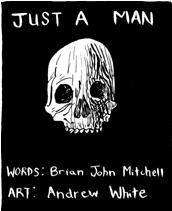
JUST A MAN #1 By Brian John Mitchell and Andrew White
This isn’t really what I would consider a comic, web or otherwise. Yes, it has sequential art but each panel is on its own page; it seems to me part of the art of comics is arranging panel layout for a proper visual and reading flow. The art is…very basic. A step up from stick figures. I’m not sure I can say much else about it. The writing is pretty basic as well, as each page (or rather, panel) has a first person narration caption that tells you exactly what’s going on. This isn’t really for me, although perhaps someone else will get more out of it. – Matt Adler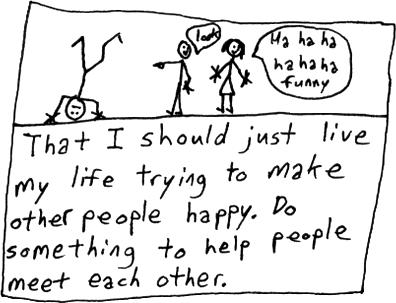
LOST KISSES #9 & 10 By Brian John Mitchell
This comic, however, is literally stick figures. I’m not sure if it’s supposed to be autobiographical. The author seems to be musing somewhat morbidly on his life, his career as an artist (???) and interactions with other people. It’s pretty self-absorbed, but worse, it’s completely uninteresting. The lettering consists of crudely done hand-lettering for word balloons and what appears to be the Times New Roman font for the captions (come on, couldn’t we at least get a more interesting font? It’s not like it would have taken any more effort to point and click). Bottom line, I can’t fathom anyone who would be interested to read this. – Matt Adler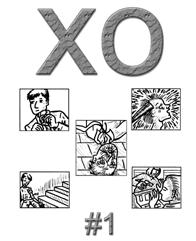
XO #5 By Brian John Mitchell and Melissa Spence Gardner
This comic comes the closest to actual cartooning, although it still uses the “one panel per page” format. This series is about a hired killer, again, narrating his adventures in the first person. Once again, the writing is pretty perfunctory, and has no real voice to it. But at least the story has a little more to it. Overall, reading these comics was a chore, and not something I’d ever want to do again. If writing them makes the author happy, more power to him, but I don’t see this as a career for him unless he manages to improve by leaps and bounds. – Matt Adler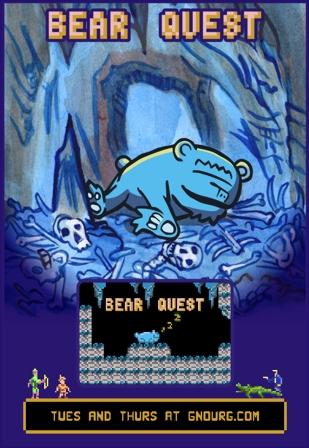
BEAR QUEST By Zach Taylor
BEAR QUEST is as creative as it is fun. At the top of every entry, you get the adventures of a one eyed blue bear who gets into adventures with hunters, crocogators, hippos, carnivals, and mysterious shadow creatures. At the bottom of the page, you get the same thing, except the action is depicted in the pixellated style of the old Atari Game System. Both are fun to read and it's even more fun to compare the sequential action to the pixellated version of the story below. One of my favorite parts of the story was a page where the bear gets into a stare down with a hunter. There's a panel with the hunter, then one with the bear, just staring at each other. How is this dramatic pause translated below in the video game version? Why the game has been paused, that's how. Clever things like this make this a cut above other web attempts. I also love it that when the bear dies, the story isn't over, he just wakes up in his cave and the game starts all over again. The way creator Zach Taylor understands both the comics and video game media is exceptional. This is a silent story aside from captions like BEAR POW+D at the bottom of the page, which makes for a quick read. And it's something you can flip through at lunch at work and definitely worth clicking on. – Ambush Bug
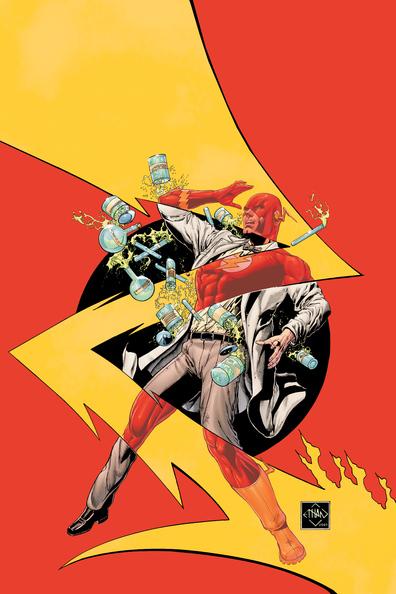
FLASH: REBIRTH #4 DC Comics
As good as GREEN LANTERN is, I have to say, Geoff Johns' FLASH pales in comparison. It's not necessarily a bad miniseries, but whereas Johns is telling compelling GL stories, here he is telling a necessary one. Basically, Johns is laying the groundwork for next year's big FLASH relaunch--establishing the mythos, asking new questions, offering new theories about the Speed Force and those who harness it. But in order for GL to be as good as it is now, we had to trudge through a bit of tedium. Unfortunately, FLASH: REBIRTH is that tedium. With very slow plot pacing, a plethora of characters, and a whole lot of discourse, reading FLASH is not a quick read--a no no for a FLASH book. But some of the ideas like ***SPOILER*** the revelation that Barry didn't harness the Speed Force that fateful night with the lab coat and the lightning and the chemicals and the 'splosion--he actually invented it-- ***END SPOILER*** are kind of cool, if you ask me. And given Johns’ track record (pun intended) with FLASH, I tend to think he’ll trudge through all of this necessary establishing stuff and come out with a winner. Although I think there are too many Flashes in the kitchen these days, this miniseries did succeed in making Barry Allen interesting again. – Bug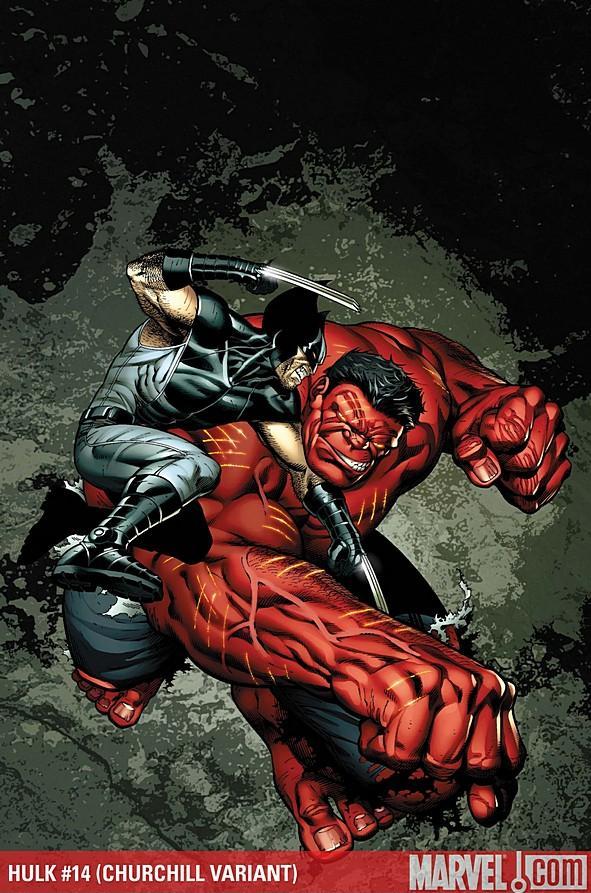
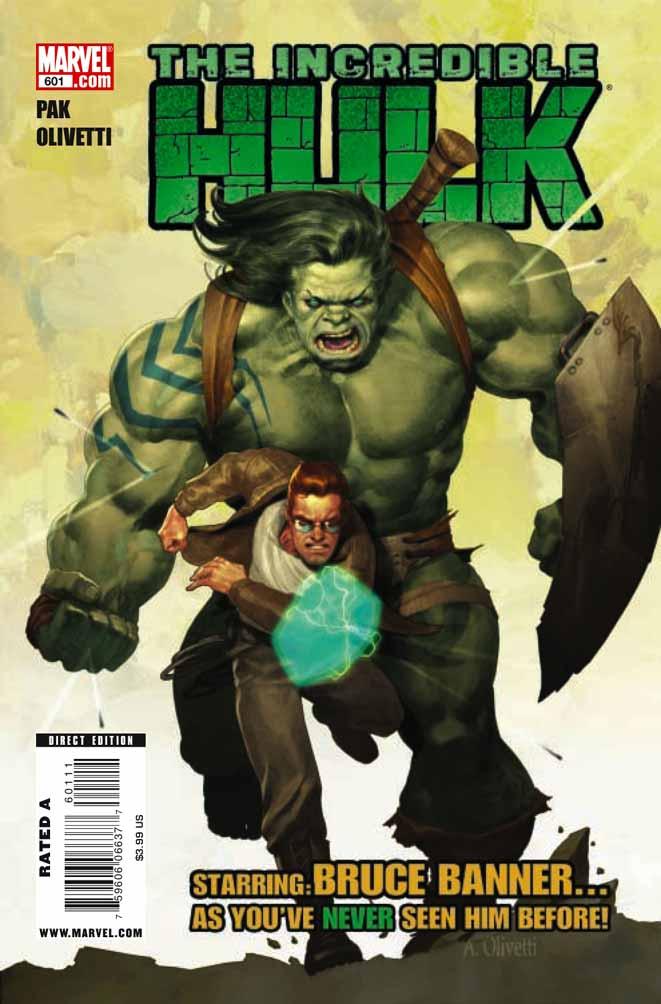
HULK #14/ INCREDIBLE HULK #601 Marvel Comics
Marvel needs to space out its HULK books, dontchathink? Not only did these two books come out last week, but SON OF HULK did too (I don't even want to go into that unnecessary title--OK, I will--why is there a SON OF HULK title still when the Son of Hulk is in INCREDIBLE HULK being looked after by a depowered Banner? I mean, the sword and sorcery stuff is OK and it's Paul Jenkins writing so that is cool, but the only reason I was reading the title was to see the SULK (Son of Hulk) head back to Earth for some Daddy Revenge and now that that's happening, let's put the final nail in this one, can we? BUT I DIGRESS...!) The new status quo of the Hulk is kind of cool. Rulk is causing chaos in HULK while, as I said before, depowered Banner and Sulk are in INCREDIBLE. HULK first: this was actually the first issue of HULK that I actually felt Loeb tried to write cohesively instead of just tossing story ideas together. Domino sees a depowered Rulk duck into an alley and change into the Big Red One. Rulk wants to kill her for that. Sure, it's stupid that Rulk has to gather another cadre of red clad warriors (Thundra, Elektra, Crimson Dynamo...damn they're stretching it with that one), but we actually get into Rulk's head and get a bit of explanation as to why Hulk is dumb then smart then crafty. Thanks, Loeb, for actually trying this issue. As for INCREDIBLE, Greg Pak--who with Fred Van Lente has been half the awesomeness behind INCREDIBLE HERCULES--does a great job of setting up some cool scenes as Banner returns to New York for the first time after World War Hulk. Of course, he's met by basically the entire super powered community. Pak does a great job of writing Bruce and I look forward to reading more of this book. With Loeb actually trying and Pak delivering the goods, the Hulk is in better shape than ever before. And that makes this Hulk fan happy. - Bug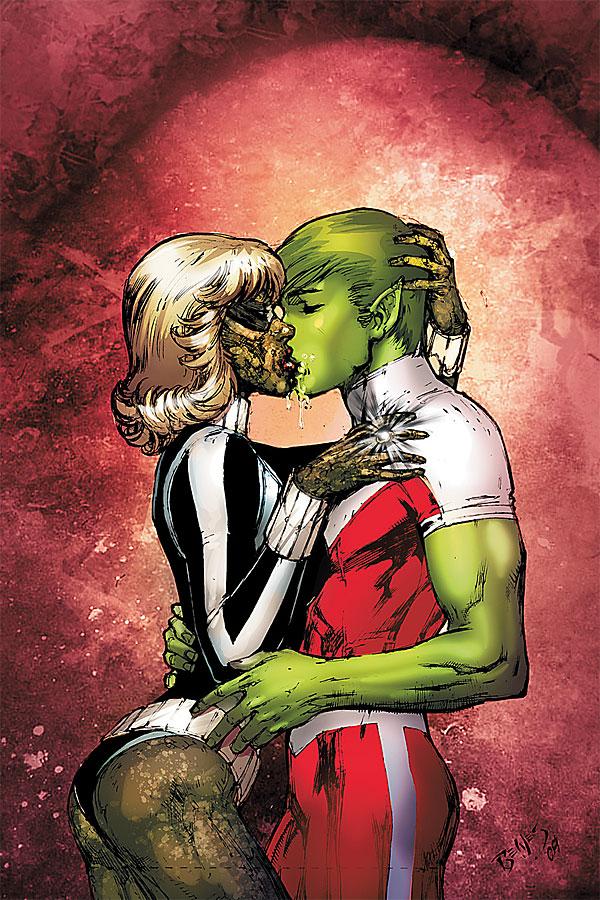
BLACKEST NIGHT: TITANS #1 DC Comics
Although I ditched the TITANS and TEEN TITANS books a while back, the completist part of me AKA the enemy of my bank account made me pick this one up and it turned out to be a pretty damn good read. Although the premise is becoming pretty worn thin (buncha heroes are honoring the dead and then, BLAZAMMO, all of a sudden heroes are met with zombified versions of either their own legacy or folks they've lost), this one hits home because the Titans have lost a shitload of teammates. It's weird focusing on Hawk and Dove, but for the first time in...ever, I actually felt invested in the pair of characters. Some nice characterization by writer J.T.Krul and capable art by Ed Benes make this a worthwhile read. - Bug